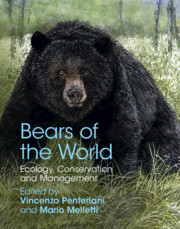Book contents
- Bears of the World
- Bears of the World
- Copyright page
- Dedication
- Frontispiece
- Contents
- Contributors
- Foreword
- Acknowledgments
- Introduction
- Part I Systematics, Ecology, and Behavior
- Part II Species Accounts
- Part III Human–Bear Coexistence
- Part IV Conservation and ManagementConservation and Management
- Chapter 20 Conservation and Management of Bears
- Chapter 21 How Is Climate Change Affecting Polar Bears and Giant Pandas?
- Chapter 22 Managing for Interpopulation Connectivity of the World’s Bear Species
- Chapter 23 Ex Situ Conservation of Bears: Roles, Status, and Management
- Chapter 24 The Challenge of Brown Bear Management in Hokkaido, Japan
- Chapter 25 Potential Ecological Corridors for Remnant Asiatic Black Bear Populations and its Subpopulations Linked to Management Units in Japan
- Chapter 26 Captive Bears in Asia: Implications for Animal Welfare and Conservation
- Chapter 27 Human Dimensions of Asiatic Black Bear Conflicts and Management in Japan
- Chapter 28 Ecological and Social Dimensions of Sloth Bear Conservation in Sri Lanka
- Index
- Miscellaneous Endmatter
- Plate Section (PDF Only)
- References
Chapter 26 - Captive Bears in Asia: Implications for Animal Welfare and Conservation
from Part IV - Conservation and ManagementConservation and Management
Published online by Cambridge University Press: 16 November 2020
- Bears of the World
- Bears of the World
- Copyright page
- Dedication
- Frontispiece
- Contents
- Contributors
- Foreword
- Acknowledgments
- Introduction
- Part I Systematics, Ecology, and Behavior
- Part II Species Accounts
- Part III Human–Bear Coexistence
- Part IV Conservation and ManagementConservation and Management
- Chapter 20 Conservation and Management of Bears
- Chapter 21 How Is Climate Change Affecting Polar Bears and Giant Pandas?
- Chapter 22 Managing for Interpopulation Connectivity of the World’s Bear Species
- Chapter 23 Ex Situ Conservation of Bears: Roles, Status, and Management
- Chapter 24 The Challenge of Brown Bear Management in Hokkaido, Japan
- Chapter 25 Potential Ecological Corridors for Remnant Asiatic Black Bear Populations and its Subpopulations Linked to Management Units in Japan
- Chapter 26 Captive Bears in Asia: Implications for Animal Welfare and Conservation
- Chapter 27 Human Dimensions of Asiatic Black Bear Conflicts and Management in Japan
- Chapter 28 Ecological and Social Dimensions of Sloth Bear Conservation in Sri Lanka
- Index
- Miscellaneous Endmatter
- Plate Section (PDF Only)
- References
Summary
For thousands of years, bears have been kept in captivity to generate income for people. To this day, throughout Asia, three main types of commercial use persist: bear baiting, bear dancing, and bear bile farming. Through these uses tens of thousands of bears are being subjected to conditions that are highly detrimental to their welfare through physiological and psychological impairment during capture, transport, training, and captive conditions. All bear species endemic to Asia, as well as most brown bear populations in Asia, are recognized as threatened with extinction and listed under CITES Appendix I, making any international commercial trade in live animals or their parts illegal. Unfortunately, some countries maintain national legislation that allows for commercial trade or use of bears within that country. Furthermore, illegal international trade is continuing to pose challenges to law enforcement and the conservation and protection of bears worldwide. In this chapter we draw attention to the historic backgrounds, current situation, and holistic approaches that are needed to address these complex issues that are impeding bear welfare and conservation in Asia.
- Type
- Chapter
- Information
- Bears of the WorldEcology, Conservation and Management, pp. 364 - 369Publisher: Cambridge University PressPrint publication year: 2020

